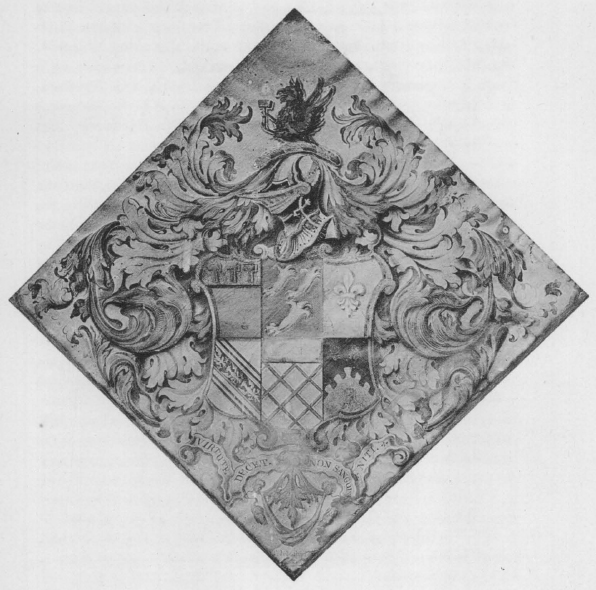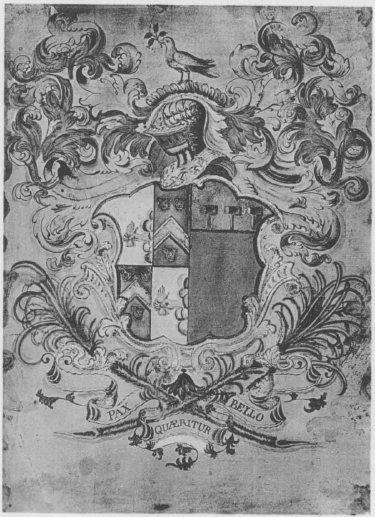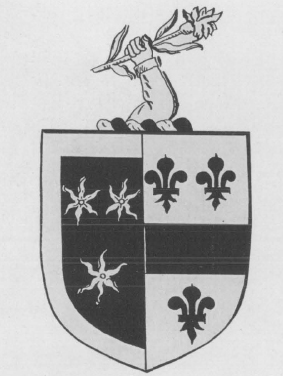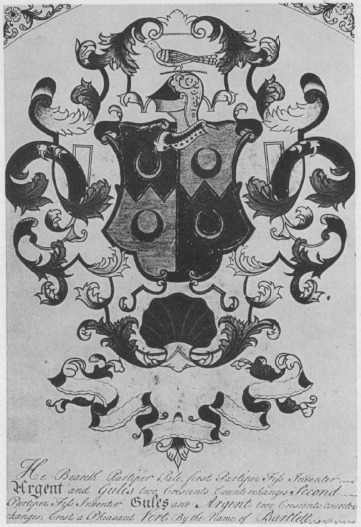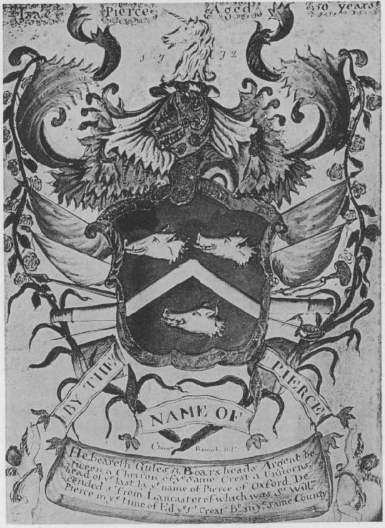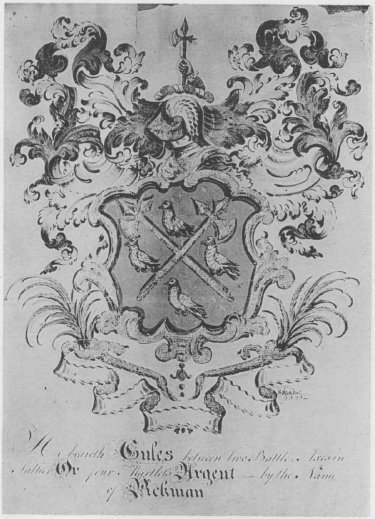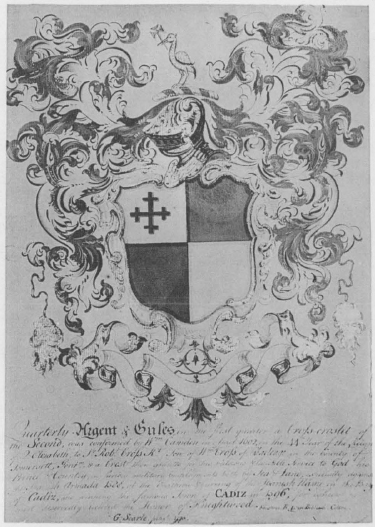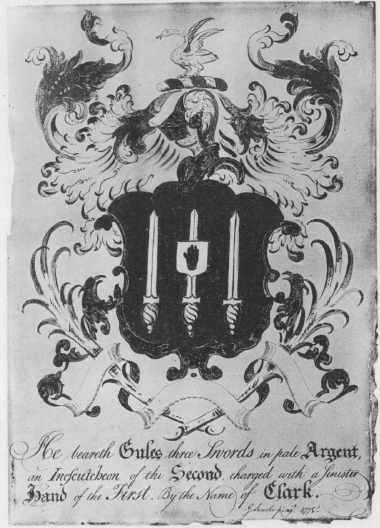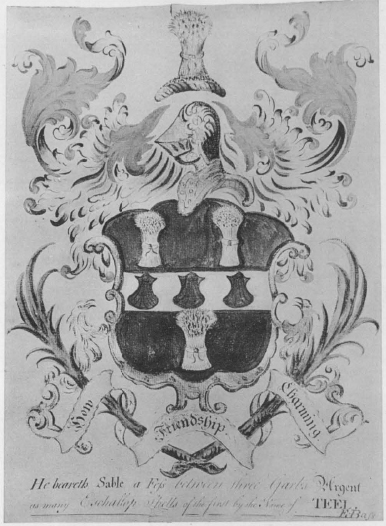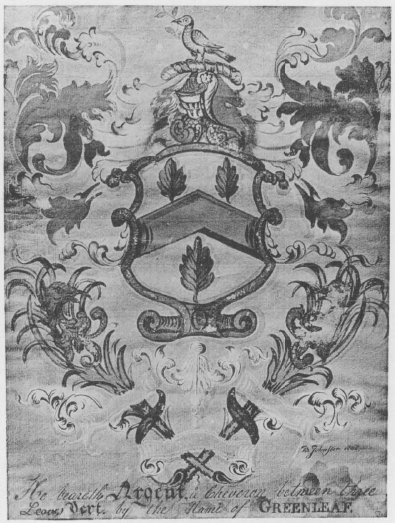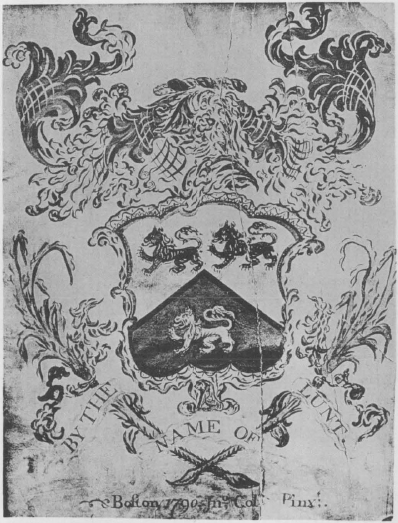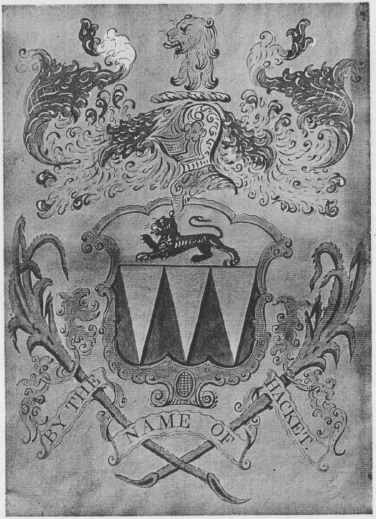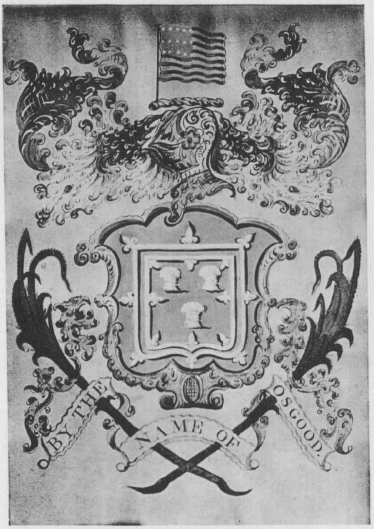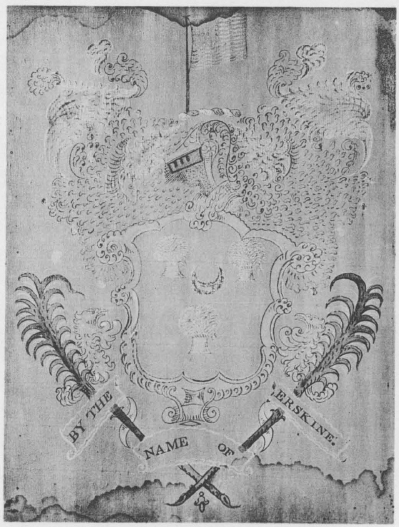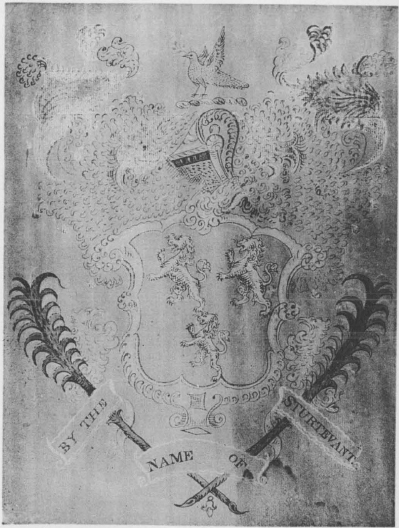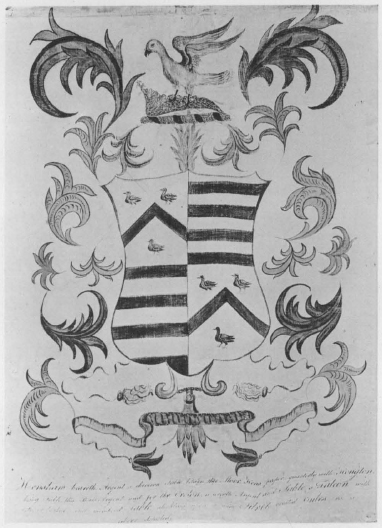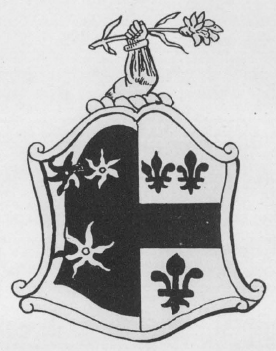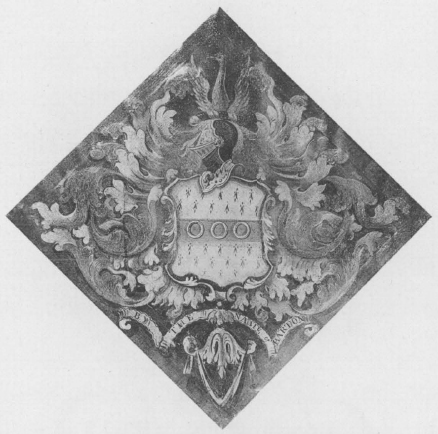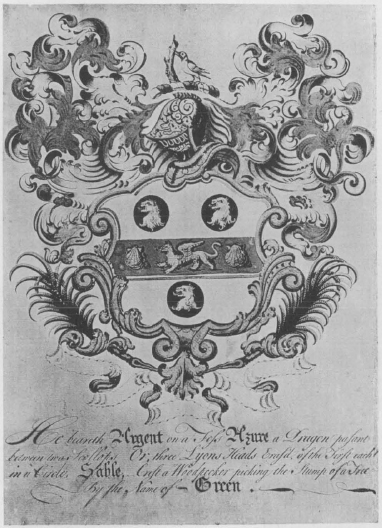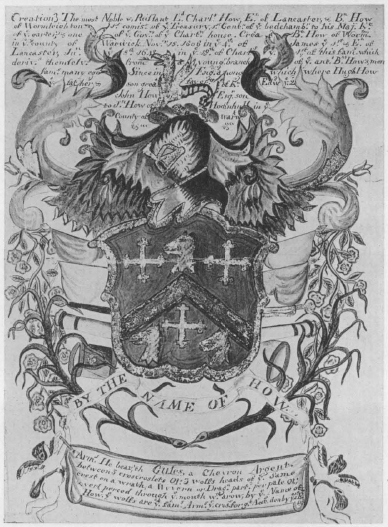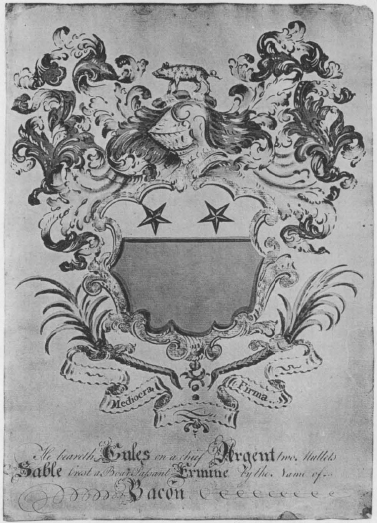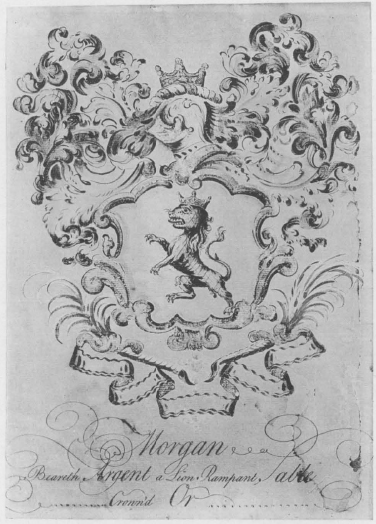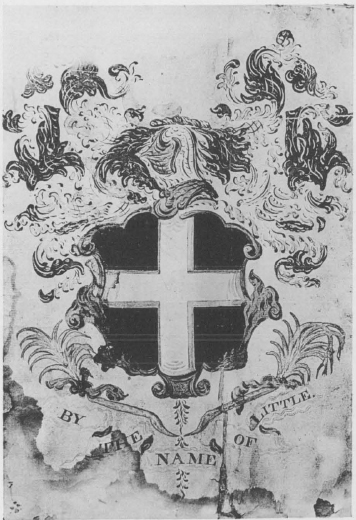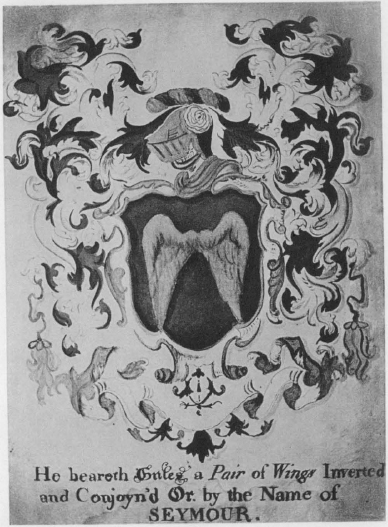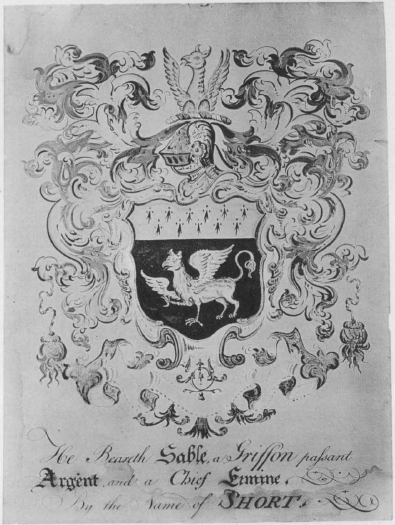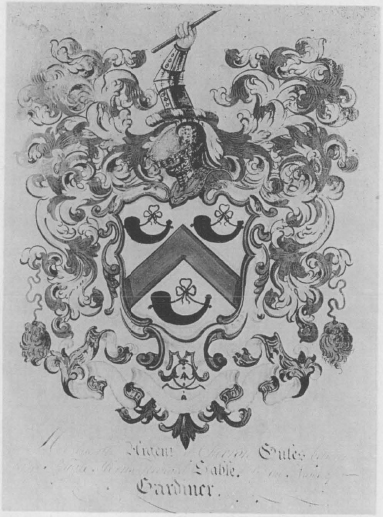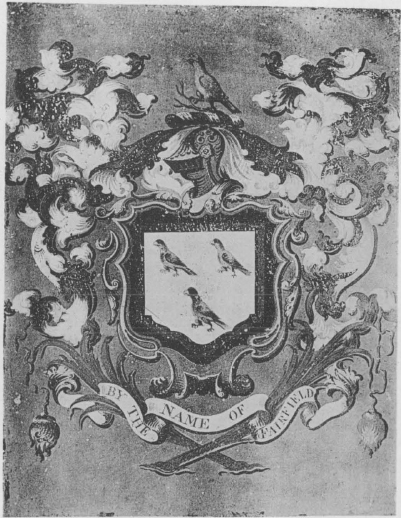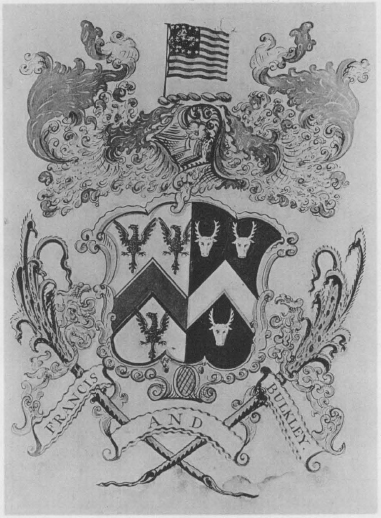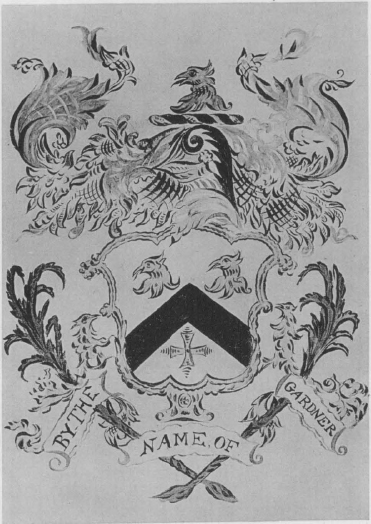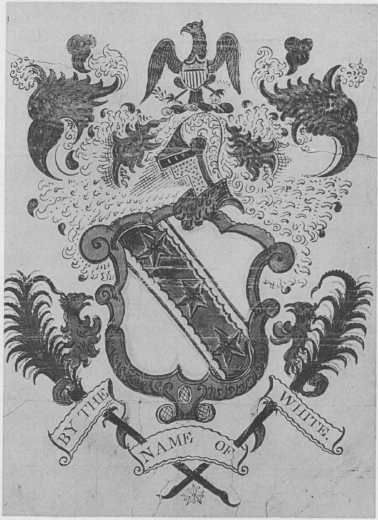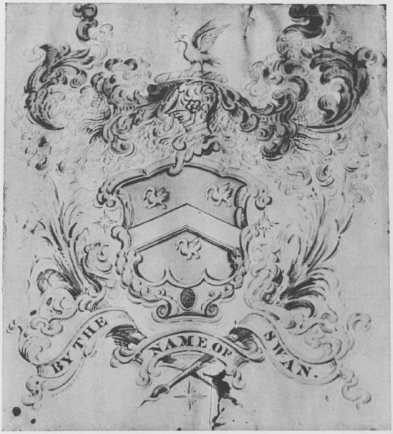December Meeting, 1944
A STATED Meeting of the Society was held at the Club of Odd Volumes, No. 77 Mount Vernon Street, Boston, on Thursday, December 21, 1944, at three o’clock in the afternoon, the President, Kenneth Ballard Murdock, in the chair.
The records of the Annual Meeting in November were read and approved.
The President reported the receipt of letters from Mr. Samuel Williston, accepting election to Honorary Membership, and from Mr. Charles Dyer Childs and Mr. Norman Lewis Dodge, accepting election to Resident Membership in the Society.
Mr. Ralph Henry Gabriel, of New Haven, Connecticut, and Mr. Raymond Phineas Stearns, of Urbana, Illinois, were elected Corresponding Members of the Society.
Dr. Harold Bowditch read the following paper:
Early Water-Color Paintings of New England Coats of Arms
THE fashion of a general interest in heraldry waxes and wanes. Perhaps as good an index of this interest as any is the demand for books on the subject. Thomas Moule’s Bibliotheca Heraldica (London, 1822) lists, reign by reign and year by year, the books published in England which have heraldic interest. The reign of Queen Anne (March 8, 1702–August 1, 1714), seems to have been a barren period for literature on heraldry; there were books on the succession, on the genealogy of the House of Stuart, on titles and privileges and the like, all of which must have had more or less heraldic interest, but the only book devoted to the subject of heraldry was by a Scotsman, Alexander Nisbet, An Essay on Additional Figures and Marks of Cadency (1702). Seven years later the first edition of the Peerage of England by Arthur Collins made its appearance; of this an enlarged and corrected second edition came out in 1710, a second volume was added in 1711, and the third edition, in two parts issued in 1714, was followed by a supplementary volume in 1716. Obviously the book responded to a fairly widespread interest, but the great popular treatise on the subject of heraldry was John Guillim’s Display of Heraldry, which had first appeared a century before and had by Queen Anne’s time been through a number of editions. There was then no general armory, nor did one appear for another half-century or more. Then as now there was an erroneous popular belief that identity of name indicated identity of family, and, as a corollary, that all of one name had a right to the same arms. Hence, if a name were found in a book of heraldry, there was no hesitation on the part of those with the same (or with a similar) name in adopting as their own the arms which were given in the book.
The accession of George I (August 1, 1714) marked the beginning of a new dynasty, and there was a veritable flood of books on the Hanoverian genealogy, the orders of knighthood, politics, biography, ceremonials, titles, and the like, besides several works on the peerage and baronetage. Heraldry as a subject in itself is represented by Samuel Kent’s Grammar of Heraldry (1716, 1719, and 1724), Nisbet’s Ancient and Modern Use of Armories (1718) and System of Heraldry (1722), a new edition of Guillim’s Display of Heraldry (1724), James Coats’s A New Dictionary of Heraldry (1725), and Kent’s The Banner Display’d (1726–1728, reprinted in 1755).
As before, Guillim’s Display of Heraldry was the standard work on the subject. The first edition appeared in 1611, a small folio of 290 pages measuring about 11 by 7 inches and weighing less than half a pound. The book is a treatise on heraldry and not an armory, but the arms of individuals are used to illustrate the text, and a common form of statement is this example: “Hee beareth Azure, six Mullets; three, two, and one, Or, by the name of Welsh.” The work went through a number of editions, gradually increasing in size and contents and culminating in the so-called sixth edition of 1724, a tall folio of 854 pages measuring about 15½ by 9½ inches and weighing a little over ten pounds. The quotation just cited, as well as many others like it, is retained in this last edition.
Kent, in his Grammar of Heraldry, a small book, illustrates many family coats of arms, but there are many more in his two-volume The Banner Display’d. This he calls “an Abridgment of Guillim,” and Thomas Moule says of the work that Kent omits the philosophical digressions and inserts above three thousand coats. The publication of these works in the years 1724–1728 put into the hands of coach painters, funeral arms designers, engravers, and such people a large number of family arms which were not represented in the books on the peerage, and this access to new material is probably not unconnected with the fact, noted by a number of observers, that it was at about this time that the display of coats of arms became popular in New England. It is known that Guillim’s Display of Heraldry was in the hands of John Coles of Boston, a publisher and heraldry painter, and it can be shown that his copy was the edition of 1724; it has been thought that this book was his only source, but there is evidence that he also used Kent’s The Banner Display’d. Another copy of the 1724 edition of Guillim is thought to have been owned by George Searle, an arms painter of Newburyport, and is known to have been owned by his successor, Edward Bass; it is, in fact, still in the possession of Bass’s descendants.
At this period certain families had accumulated a good deal of wealth, and it seemed to them appropriate to have arms engraved on silver, chiseled on gravestones, embroidered on silk or other fabrics, and painted in oils for hatchments or in water colors as ornaments. The custom in England was to display on the front of the house whose owner had died his coat of arms painted on a square panel of wood or canvas, hung by a corner. This was called a hatchment, and a number survive in this country. After six months or more the hatchment was taken down and was sometimes preserved in the local church. The shape of the hatchment probably suggested the form which became common in embroideries and less so in water-color paintings; but these ornaments were not intended to be exposed to the weather and cannot properly be called hatchments.1
The fashion of having arms painted in water color seems to have begun a few years later. At any rate, the earliest date attributed to an American example is 1740 when the owner wrote an inscription on the back, although, of course, the work itself may be somewhat earlier. The paintings were produced, in a certain easily recognized type, for about a hundred years. Richard C. Lichtenstein says:
From 1750 to 1775 there was hardly a family of wealth or social distinction but could show its family arms engraved and used as a book-plate, or painted by some of the numerous herald-painters who flourished during that period . . . For several years after the Revolution, the use of Coats of Arms seems to have fallen slightly into disfavor, the period of 1780 to 1810 being a seemingly barren one. Cooper, in his “Notions of an American picked up by a Traveling Bachelor,” speaks of John Cadwalader, of New York, as having destroyed his arms, presumably on account of his intensely Republican sentiments.2
With regard to bookplates Lichtenstein may be presumed to be right; but the period from 1790 to 1830 was the period of mass production of painted arms in Boston. It seems not unlikely that the economic situation had something to do with it: after the war people were poor, and a water color would cost far less than an engraved bookplate. The Reverend William Bentley of Salem, in his Diary under the date of October 15, 1806, speaking of heraldry, says: “No study is so singular as this in the United States. The Revolution has extinguished even the wish to get money by drawing arms & selling them, as was done in a few instances before the revolutionary war.” By 1806 Samuel Blyth of Salem, portrait and heraldry painter, had been dead for eleven years, so it may be presumed that he had left no successor there; but 1806 falls in the period of activity of both the elder and the younger John Coles of Boston and of Edward Bass and Benjamin Johnston of Newburyport, and there was accordingly no lack of arms painters elsewhere than in Salem.
These paintings of family arms, now anywhere from one to two hundred years old, are highly prized as heirlooms, and many have served as models for heraldic bookplates and the like. Yet in themselves they have no authenticity. Some were made up from the whole cloth, and others are merely the arms, as given by Guillim or Kent, for the name in question or something like it, but without proof of any connection. It is hardly necessary to state that the mere use of the arms of a family of the same or of a similar name does not constitute a valid claim to a right to bear those arms. The late date of the paintings, too, takes from them any claim to authenticity, for by the period when they were painted, arms were being taken—from the books—right and left. Some, it is true, can be shown to be valid, but through evidence earlier than that of the production of these paintings.
In the case of any one of these early water colors two questions naturally arise: (1) Who painted it? (2) When was it painted?
As for the painters of arms, some few are known by name, for their signatures appear on their pictures. Names of heraldry painters may also be found in the early lists of inhabitants, though their work may not be known. The great majority of the paintings, however, are unsigned and undated, and it has therefore seemed worth while to bring together a group of signed or otherwise well-authenticated paintings in the hope that, from comparison of an anonymous painting with a signed example, the authorship of the unsigned work may be established with reasonable certainty.
Engravings of arms of a date earlier than paintings of arms have come down to us, probably because silver and copper are less perishable than paper and canvas and also more valuable intrinsically. The engravers and seal cutters would seem to be natural arms painters because the first step in making an engraving would, of course, be a design on paper which could then be easily colored and framed as an ornament. Hence a list of engravers may offer a clue to the author of some painting signed only by initials. Such lists of painters and engravers may be found in Mantle Fielding’s Dictionary of American Painters, Sculptors and Engravers, George F. Dow’s Arts and Crafts in New England, Richard C. Lichtenstein’s list in E. de V. Vermont’s America Heraldica (supplement) and in The Curio, Charles Dexter Allen’s American Book Plates, and Louis F. Middlebrook’s “New England Engravers,” Essex Institute Historical Collections, lxii (1926), 359–363.
The approximate date of a painting of arms may be surmised by one of several pieces of evidence. If the design is like that of a signed example and the place is appropriate, the dates of birth and death of the artist, or the time when he is known to have worked, give a reasonably good clue. In the case of quartered arms the date when the latest quartering “came in” by marriage will give the earliest possible date; and in the case of impaled arms (the husband’s on the dexter and the wife’s on the sinister side) the date of their marriage, if it can be obtained, again gives the earliest possible date. In fact, in the latter case it seems not improbable that the arms were painted shortly after the marriage to hang in the house as an ornamental memorial of the event. In the case of paintings by Coles, who not infrequently used the national flag as a crest, the number of stars and stripes may lead to a conclusion concerning the date of the work.3 There were certain official rules governing the design of the flag, but, especially in the early years of the Republic, the rules were disregarded even in the case of flags actually used on government service. An instance in point is the flag flown by Commodore Perry in 1853, which showed twenty-nine stars instead of thirty-one. The official number of stripes was never larger than fifteen, but the original scheme of adding a stripe as well as a star for each new state led to curious flagmaking as late as 1818, in spite of official rules. How much more likely it is that such mistakes would be made in drawings and paintings.
Finally, the paper itself may offer some clue. Although wove paper was in use here as early as 1781, it did not become common until about 1800. Hence a painting on wove paper instead of laid paper suggests a date from 1800 on. If laid paper was used, as was commonly the case, it does not suggest any date, for it continued in use long after the introduction of wove paper. Watermarks might seem at first sight to be valuable clues, but there are serious pitfalls. In the first place, minor differences are legion. Again, a given watermark may be repeated for years, decades, even centuries. Furthermore, good pieces of paper were often laid aside for future use even as is done today. On the other hand, a collection of watermarks, with the dates when they were used, makes it possible in some cases to state that a certain watermark is appropriate to a certain period and place. Some paper is watermarked with the year of its manufacture, and, since paper was scarce and expensive, the probability is that it was used not long after being made. Yet in France a law was passed in 1741 that all paper made after January 1, 1742, must be watermarked “1742”; and this was literally carried out, in some cases even to the end of the century. Hence, French paper watermarked 1742 shows only that it is not earlier than that date.
Figure 1
Arms of Lynde and others. “T Johnson fecit”4
This beautiful painting is quartered of six, showing the arms of Lynde, Newdigate, Digby, Browne, Curwen, and Smith. On the back is a paper stating that “The arms on the other side belong to Benj. Lynde Jr. of Salem, 1740.” This, then, is the latest date at which the arms could have been painted. In style this painting is far better than any of the others which follow. Although the shape of the shield is “Jacobean” and unlovely, its scrolled edges are logically carried out; and the crest-wreath, although it does not surround the helm as it should, is at least not straight like a barber’s pole. The mantling is really fine, and the motto-ribbon is occupied by the motto and not by the name of the bearer of the arms. At the lowermost corner there is a finial which matches well with the mantling, and hung from it is a small scarf, a type of ornament which is at least as early as about 1500. It may be the point of origin of the curious curtains later employed by Christian Remick and Nathaniel Hurd. In shape and placing this painting is like a hatchment, but the background is not black and it is a water-color painting on paper. A thoroughly inadequate and misleading woodcut illustration of this painting is given by William H. Whitmore in the Heraldic Journal5 and in his Elements of Heraldry (1866); but Whitmore was working more than eighty years ago when the woodcut was the only means of illustration. The painting measures about a foot square and is on buff-colored paper which was probably originally white.6
Thomas Johnson (whose name is frequently found spelled Johnston) was born in 1708. While best known today as the engraver of highly prized and now rare views of Boston and of Louisburg and a map of the Battle of Lake George, there are references to him as a japanner and a heraldry painter. The Record Commissioners’ Reports state: “1729 26 Feb. a shop at 9 Dock Square owned by the town leased to Thomas Johnson of Boston, Painter Stainer, for 7 years from 1 Jan. 1729, and, 1730 21 Aug. the above-mentioned shop, having been resigned by Mr. Thomas Johnson, was let to John Cravatt, feltmaker.” Presumably the same individual is meant in a later entry: “1747 2 March Petition of . . . Thomas Johnson for Liberty to Build a Shop on the Towns Land at the head of the Dock . . . to be considered 14 March. 16 March the Petition of Thomas Johnson praying for Liberty to Build a Shop on the North Side of Faneuil Hall Market was . . . pass’d in the Negative.” Between 1730 and 1747 there are records of four marriages or marriage intentions of Thomas Johnson (Johnston): June 22, 1730, to Rachel Thwing; March 30, 1733, to Rachiel Rebrooke (intentions); June 1, 1739, to Susanna Mackmillian; and August 6, 1747, to Bathsheba Thwing. Probably all of these did not refer to the same man, but the engraver’s will shows that his widow was named Bathsheba, and it seems not unlikely that she was his second wife, Rachel Thwing having been his first. Johnson died on May 8, 1767, aged fifty-nine years, and was buried in King’s Chapel Burying Ground. The inventory of his estate includes “glass arms, 4s” and a “Book of Heraldry, 48s.” This book may well have been the 1724 edition of Guillim; in fact, it may have been the very copy later owned by John Coles of Boston. In the Heraldic Journal, ii. 76, there is mention of an item in the accounts of the Honorable William Clark, merchant, 1742: “Paid Johnson for escutcheons and coat of arms and (stockn for House)? £57.” The strange word might be “scochn,” i.e., scutcheon, or hatchment.
Figure 2
Arms of Oliver and others. Unsigned7
This painting bears no artist’s signature; but below the middle fold of the motto-ribbon there is an erasure where the painter probably had signed his name. Why it should have been erased is unknown. Although the painting is anonymous, the circumstantial evidence strongly points to James Turner of Marblehead. The palm branches crossed below the shield, so familiar a feature of paintings of this sort, appear in this example. The arms are those of Oliver quartering Fitch and impaling Lynde. The match which is here memorialized is that of Andrew Oliver, Jr., and Mary Lynde, who were married on May 28, 1752, the earliest possible date for the painting. Only eighteen days before (May 10, 1752) William Lynde, the second of the two sons of Benjamin Lynde, Sr., and uncle of Mary Lynde, the bride, had died.
The honble Benj. Lynde Esqre, Samuel Curwin, Esqṛ and Mr. Henry Gibbs, executors to the last Will & Testament of Mr. Wṃ Lynde, decḍ
|
To James Turner, |
Dr. |
||
|
1752 May 14. |
To 8 escutcheons for ye Funeral of ye Decd at 8s aps |
£ 6. |
|
|
To an Inscription on ye Breastplate of ye Coffin |
,, 8. |
||
|
June 6 |
To 9 Enamell Rings for do. wt 13 dwt. 23 gr |
|
4 ,, 4. |
|
To fastening ditto at 9s 4 aps |
|||
|
9 |
To adding a Crescent for Difference 2s aps. |
11 ,, 0. |
|
|
to each of the escutcheons at |
|||
|
Marblehead, Sep. 2, 1752.8 |
|||
Subsequently his executors received a bill from James Turner which shows that he was an engraver. Whether he was also a painter is not clear. Yet the fact that less than three weeks before Mary Lynde’s marriage he had been doing armorial engraving for her uncle’s funeral, and the presence of the Oliver-Lynde arms, suggest that he was. That the Lyndes took their heraldry seriously is shown by the fact that on the ninth of June, nearly four weeks after the funeral, they went to the trouble of having the crescent which indicated the second son added to the funeral escutcheons.
This painting, like the preceding, was badly illustrated by woodcut in Whitmore’s Elements of Heraldry (p. 74), where he called it “probably the work of Hurd,9 or of his contemporaries,” which is a pretty feeble statement. He reprinted the cut in the Heraldic Journal (iii. 31), stating that it “may be attributed to Nathaniel Hurd.” Hurd was of the right age, twenty-three years old in 1752, and the painting may be later. But no heraldic paintings from his hand are known, and there is nothing in this painting to suggest his well-known style. He lived in Boston, and James Turner, heraldic engraver, was closer at hand in Marblehead.
The style shows a distinct falling off from the work of Johnson in 1740. The curiously shaped shield, which was in the fashion of the time, develops two meaningless extensions at the lower sides, the crest-wreath lies upon the mantling above the helm, and the mantling is less skillfully turned than is Johnson’s. The palm branches, which are so commonly looked upon as the earmark of Coles’s work, have been mentioned. The artist had the grace to use the motto-ribbon for its real purpose. Note also the tulip-shaped finial at the foot of the shield, now introduced above the ribbon instead of below it. There is in the Museum of Fine Arts in Boston an unsigned painting of the Green arms (Fig. 19) which is closely affiliated with this work supposed to be James Turner’s. Joseph Green (1675–1715) lived in Salem and left seven or eight children, for one of whom this painting may have been made by the Marblehead heraldic engraver.
It is impossible to establish with any certainty the identity of this James Turner or the facts of his life. A person of this name, the son of Isaac and Mary Turner of Marblehead, was baptized in the First Church of Salem on March 4, 1722. If this was the engraver, he was thirty years old when the Oliver-Lynde arms were painted.10 Another record shows that on August 26, 1759, Priscilla, the infant daughter of James and Mary Turner, was baptized in Salem Middle Precinct (later South Danvers). If this James was the engraver, it would appear that by 1759 he had moved from Marblehead.11 I do not believe that James Turner of Marblehead was identical with James Turner of Boston, engraver, who is mentioned in many source books. Although the Boston man made and engraved silver for Richard Derby of Salem in 1746 and had been working at his art in Boston at least as early as 1745 he moved in 1758 or before to Philadelphia, where he died the next year.12 If he worked for the Lynde funeral in 1752, he would have had to make the following moves: Boston by 1745 and in 1746, Marblehead in 1752, Philadelphia by 1758. It seems to me more likely that there were two James Turners, silversmiths and engravers, one in Marblehead and the other in Boston and Philadelphia. A further argument in favor of the Marblehead man is the fact that the style of design used by Samuel Blyth of Salem at a later period (see Figure 6) was influenced by whoever produced the Oliver-Fitch-Lynde arms and the Green arms, and he would have been more likely to see the work of a Marbleheader than of a Bostonian.
Figure 3
Arms of Stoddard and Evance. By John Gore
This illustration is made from a careful copy of one of the many paintings in a manuscript book known as the “Gore Roll of Arms.” For many years the original was lost to sight, and the arms were known only through a copy made by Isaac Child and now the property of the New England Historic Genealogical Society. From this copy Whitmore first described the arms, along with the others in the manuscript, in the Heraldic Journal, 1 (1865), 122, and he reprinted the list, with different numberings (having omitted such arms as were not American), in his Elements of Heraldry. The first Whitmore list and description were reprinted in the 1889 supplement of Vermont’s America Heraldica. About fifteen years ago the original “Gore Roll” came to light, and it was then found that Child’s copy was so inaccurate that a new description was called for.13 The “Roll” is simply a record of arms and crests, showing no helms, and consequently no mantlings, and no mottos. The names of the bearers are given (in this instance Simeon and Elizabeth [Evance] Stoddard of Boston), and most of the paintings bear dates, one as early as 1682, the others between 1701 and 1724. As these dates are too early for John Gore, whose name is given as the artist in a penciled inscription on the flyleaf of the book, it would seem that the “Roll” represents a gathering between two covers of such coats of arms as had attracted Gore’s attention, some coming presumably from the notes of an earlier heraldic painter in Boston.
The Gores were an old Roxbury and Boston family. Obadiah Gore, a carpenter, married Sarah Kilby. Their son John, the reputed painter of the “Roll,” was a coach painter in Boston. Born in 1718, he had Tory opinions at the time of the Revolution and fled to Halifax in 1776 and was formally banished two years later; however, he was pardoned and returned to Boston in 1787, and died in 1796. He had three sons: John; Samuel (1750/1–1831), who followed his father’s trade and worked in Newburyport; and Christopher, Governor of Massachusetts 1809–1810. Samuel Gore had three sons, two of whom, George and Christopher, became painters, the latter being in partnership with his father in 1806 or 1807. There were thus three generations of Gores who were painters.
The arms in the “Gore Roll” are not comparable with the usual run of ornamental paintings of arms of the period with which this article deals, but it is interesting to note that Gore used the type of shield which was popular in the seventeenth century instead of the elaborate “Jacobean” type which was the favorite of his contemporaries. This type is shown in an example preserved at the New England Historic Genealogical Society, a certificate from the College of Arms, dated 1709, showing the Emerson arms in color. Although no closely related New England example has come to light, it seems probable that our local painters were influenced by the style which was set by official circles in England. The work in the “Gore Roll” cannot be accurately dated, but it seems probable that it is the work of a younger rather than of an older man, and perhaps 1750 would not be far from the mark.
Figure 4
Arms of Bartlett. “James Ford fecit 1757”
This painting and a companion piece (the Carder arms) belong to the Marblehead Historical Society. In design they are practically identical except that in the Carder arms the helm is omitted. The date 1757 is on the Bartlett example only. The design surrounding the shield is a very elaborate cartouche, skillfully conceived and logically carried out, and quite different from the work of any other known painter. A third example of Ford’s work (the Chapman arms) is recorded in the supplement to Bolton’s American Armory; if its whereabouts could be ascertained, it would be interesting to learn whether in this case, too, he followed this design.
I have not discovered where or when James Ford was born. One record, now over a hundred years old, speaks of him as an Irishman, so he probably came from Ireland to Salem where he is listed as a member of Colonel Ichabod Plaisted’s Essex Regiment in the French and Indian War in 1755. The second record about him is this painting, dated 1757. In 1758 he drew a plan of Salem which is in the Essex Institute. He belonged to the Episcopal Church; and in 1761, when St. Peter’s Church in Salem was enlarged, he worked on it as a carpenter and made a money contribution as well. He is best known, however, as the master of the writing school in Salem. The earliest mention of him in this capacity that I have seen is in 1765, when he was apparently under criticism for his violent temper, which is also mentioned elsewhere. In that year Deacon Timothy Pickering wrote to the Salem school committee, mentioning objections against Ford because he was an Episcopalian and because of his temper, and pointing out that “if he was of a winning temper I don’t know but that he would Draw one half of the Boys to Church with Him.” Evidently this argument had weight, for the fact that at his death in 1781 he was spoken of as a schoolmaster suggests that the school committee decided to face the awful risk of the conversion of the youth of Salem. The fact that he was a writing master and a cartographer is consistent with his having made paintings of arms, though his curiously elaborate description of the Bartlett arms shows that he had no knowledge of heraldry and did not even copy correctly: “He Beareth Partiper Pale, first Partiper Fess Indenter Argent and Gules two Crescents Counterchanges Second Partiper Fess Indenter Gules and Argent two Crescents counterchanges: Crest a Pheasant Vert By the Name of Bartlett.” He would have saved himself trouble by saying simply: “Quarterly per fess indented Argent and Gules four crescents counterchanged.”
Figure 5
Arms of Pierce. “Chrisn Remich14 Del:”
The painting from which this illustration is made is one of a pair, practically identical except for the arms and the crest, which were until recently in the hands of Goodspeed’s Book Shop15 in Boston, through whose courtesy the plate is lent. They are signed identically and both are dated 1772. The shield is of the shape of the period, but several new features appear. In the first place, flags, swords, cannon, etc., are introduced behind the shield, as seen in the so-called trophy bookplates of this era; in the second, trailing vines hang from the mantling, apparently related to the graceful garlands and sprays which appear in the bookplates of Nathaniel Hurd; and in the third, at the foot of the design there is a curtain which is perhaps developed from the scarf which appears in Thomas Johnson’s painting (Figure 1). A curtain is also a usual feature in Hurd’s work; and there is an example of the Smith arms painted, I am convinced, by John Coles, Sr., which shows a curtain copied exactly from Remick’s work, including the two supporting cupids bashfully turning their heads away. The mantling in Remick’s painting is sui generis: the folds have curious serrated edges and knoblike terminations which are unlike the mantling of any other herald painter. The use of the motto-ribbon for the name of the bearer of the arms is so strongly associated with the work of John Coles that it is of interest to see it in Remick’s painting, but an example presumably a good deal earlier is found in the anonymous Barton hatchment, at the Essex Institute (Fig. 18). This hatchment is in the style used by Thomas Johnson of Boston, and as Remick worked in Boston he may have picked up the idea from Johnson’s designs.
An interesting account is given in The Month at Goodspeed’s Book Shop for December, 1942, from which the following is condensed. Christian Remick was born in Eastham, Massachusetts, in 1726, the fourth generation of his family in America. He is best known for a water-color view, of which he made six known copies, of the landing of the British in Boston in October, 1768. In 1769 he advertised in the Massachusetts Gazette that he made many sorts of water-color paintings—“Sea Pieces, perspective views, Geographical Plans of Harbours”—and also coats of arms. He had then lately returned from Spain, for he was a master mariner, and in the Revolution he was a lieutenant aboard the brigantine Tyrannicide of the Massachusetts Navy and aboard the frigate La Hague. In 1777 he was taken prisoner and set ashore on the coast of Maine. The date of his death is not mentioned.
Figure 6
Arms of Pickman. “S Blyth Pinxt”16
The whole effect of this painting is poor: the shield is lopsided and its framework clumsy; the crest-wreath floats above the shield; the palm branches are angular and ungraceful. Below the shield is a small finial reminiscent of the handsome large example in Johnson’s painting (Figure 1), but much reduced in size. The motto-ribbon is empty. The late Walter Kendall Watkins wrote: “A coat of arms of the Pickman family by Samuel Blyth is at the Essex Institute, Salem, drawn in the manner of Coles, the cornstalks being broken or bent. . . . it is possible that the heraldic work by Blyth may have inspired Coles to continue it at a later time. The resemblance in design is certainly suggestive.”17 The connection was through Benjamin Blyth of Salem, son or nephew of Samuel, who became associated with Coles in Boston in the publication of engraved portraits of George and Martha Washington in 1782. The resemblance to the known work of Coles does not seem to me striking; on the other hand, there does seem to be an influence from the work of the painter of the Oliver arms (Figure 2) and of the Green arms in the Museum of Fine Arts in Boston (Figure 19), which are thought to be the product of James Turner of Marblehead. In view of the locale this seems natural, and it adds to the likelihood that Figure 2 is the work of Turner.
About the members of the Blyth family there seems to be a good deal of confusion. According to one account Jonathan Blyth (or Bly) married in 1704 and had Samuel; Samuel was baptized in 1721, was a sailmaker, married Abigail Massey in 1743 and had another Samuel; this Samuel, baptized in 1744, was a painter, married twice, and died in 1795.18 According to another account19 the Samuel Blyth who married Abigail Massey and died in 1774 was a sailmaker and also a painter, and had sons Benjamin and William, no Samuel mentioned. If he died in 1774 how can one account for a bill of July, 1782, for painting and gilding E. H. Derby’s house made out by Samuel Blyth?20 It seems, therefore, that the first account is right, and that Samuel the father was the sailmaker and Samuel the son, the painter.
Figure 7
Arms of Cross. “G: Searle. pinxt 1773”
This painting hangs in the rooms of the Historical Society of Old Newbury in Newburyport. It is evidently the work of a superior artist. Although the conventional type of shield is retained and the crest-wreath floats above the helm, the picture exhibits a certainty and a delicacy of touch better than anything in this series since the work of Thomas Johnson in or about 1740 (Figure 1). The mantling is carefully worked out, and from it depend, on turned and returned slender ribbons, two heavy tassels, a new feature in native work but found in the Emerson certificate of 1709 at the New England Historic Genealogical Society. Below the shield and partly behind the motto-ribbon (which is empty) appears a dainty and elaborate finial. The palm branches are omitted altogether. Other paintings following the design of these Cross arms, but all unsigned, are: the Short arms in the Essex Institute (Figure 25); the Seymour arms shown in the Seymour Genealogy (Figure 24); and the Gardiner arms, painted on parchment, privately owned in Hartford, Connecticut (Figure 26). The Seymours and the Gardiners are from Connecticut; Cross, too, is a well-known Connecticut and Rhode Island name. George Searle, who painted the Cross arms, worked in Newburyport; but the occurrence of these other examples in the same style suggests that he may have worked in Connecticut as well, or perhaps that he copied the work of a Connecticut arms painter.
George Searle, painter, of Newburyport (circa 1751–1796) was the nephew of John Gore, coach painter, of Boston (1718–1796), the reputed painter of the “Gore Roll of Arms” (Figure 3). John Gore’s sister, Katharine Gore, born in 1722, married in 1742 George Searle of Boston, and they were the parents of George Searle the painter. John Gore’s son, Samuel Gore (1750/1–1831), the first cousin of George Searle, was a chaise and carriage painter in Newburyport. Thus it seems that Searle may have acquired his interest in heraldry painting from his Gore connections.21
Joseph Dudley, Governor of Massachusetts, had a daughter, Mary Dudley, who married twice. Her first husband was Francis Wainwright; their child, Mary Wainwright, married Chambers Russell, who died without issue in 1766. Mary (Dudley) Wainwright’s second husband was Joseph Atkins; their child, Dudley Atkins, had a daughter, Mary Russell Atkins, who married George Searle, the painter, of Newburyport. Chambers Russell bequeathed to his “niece” (actually his wife’s half-brother’s daughter) “all his plate marked with the arms or crest of the Dudley family.”22 George Searle, then, must have been familiar with the Dudley arms on the silver left to his wife in 1766. Yet he owned (and Edward Bass after him) a small hand-stitched blankbook containing formulas for making paints, prices for painting chaises, etc., and an armory of eighty-five names and arms (not always both), chiefly of the local gentry, in which very different Dudley arms are given. This curious little roll of arms is owned by Mr. Charles C. Stockman, 2nd, of Newburyport, who has kindly lent it to me for examination. It is a strange fact that the Dudley arms are given as “Azure a chevron engrailed voided or” instead of as “Or a lion azure (or vert)” as they were used by the Massachusetts Dudleys. Searle’s blazon for Dudley is found in Guillim’s Display of Heraldry (1724 edition), and the volume which probably he and certainly his successor, Edward Bass, used is still in existence. Another reference to Searle mentions him as one of two shopkeepers in Newburyport having for sale in 1775 a view of the town from a drawing by Benjamin Johns(t)on.23 A search through the Essex Institute Historical Collections shows that between 1789 and 1795 George Searle was a part owner (in every intance but two a half owner) of no fewer than fourteen vessels ranging from sloops to brigs. A Kinsman coat of arms was painted by George Searle in 1773, but this has not been located.24
Figure 8
Arms of Clark. “G Searle pinxṭ 1775”
The original painting is in the Essex Institute. Were it not for the signatures, one would doubt that this and the preceding painting were by the same hand, and in spite of the dates the second has the earlier and more amateurish look. The poor mantling is in a way suggestive of Remick’s (see Figure 5), the narrow-throated helm is unfortunate, and—a new feature—the scrolls which continue the motto-ribbon cross the palm branches and terminate in perfectly meaningless eagles’ heads. In spite of the signature this painting has been included in a list of the work of John Coles.25 A painting of the White arms, in style identical with the Clark arms, is in the Haverhill Historical Society. In this instance there is an exception to the rule in the work by or attributed to Searle: “by the Name of White” is on the motto-ribbon, but it is in pale and very fine script and has the appearance of having been added.
Figure 9
Arms of Teel. “E. Bass”
The original painting is in the Historical Society of Old Newbury. So closely does it follow the design of Searle’s Clark arms (Figure 8) that were it not signed by Bass, anyone would be justified in attributing it to Searle. Since Bass was the younger man and Searle’s follower in his trade, he no doubt copied from Searle’s designs. The illustration does not bring out the fact that the motto-ribbon has been cut out and that the words “How Charming Friendship” are written on a piece of paper which underlies the painting.
Again we are indebted to Mr. Stockman for personal details. The Bass family came from Dorchester, Massachusetts. Bishop Edward Bass of Newburyport had a brother Joseph who is said to have gone to Annapolis, Nova Scotia, some time before the migration of the Loyalists, and thence to have come to Newburyport. His son Edward Bass, of Newburyport, was a house painter, and, as we see, a heraldry painter. The degree of association between him and George Searle during Searle’s lifetime is not known; but Searle’s manuscript book of painter’s recipes and coats of arms was in Bass’s possession and the latter part is thought to be in his hand. Bass is also known to have owned a copy of Guillim’s Heraldry (1724 edition) which has come down in the family; it is thought to have belonged earlier to Searle. Bass continued as a house painter through the first quarter of the nineteenth century and died in 1847 aged eighty-seven years, so the date of his birth was about 1760. Some painting such as the Clark arms by Searle (Figure 8) or the Teel arms by Bass (Figure 9) was apparently selected by Whitmore (Elements of Heraldry, 1866, p. 76) in order to illustrate what he looked upon as the typical work of John Coles, Sr., but he added the bearer’s name on the motto-ribbon just as Coles had it. In fairness it must be said that it is easier to study the subject now when so many of the paintings are in our local museums than it was in Whitmore’s day when they were in private hands.
Figure 10
Arms of Greenleaf. “B. Johnston del”
This painting is one of a pair, identical in style and signature, side by side in one frame, the mate representing the Newman arms. They are owned by Mr. Charles C. Stockman, 2nd, of Newburyport, who furnishes what is known of their history and of that of the artist. The style of the painting resembles in a general way that of the Clark arms by Searle (Figure 8) which is dated 1775, and its copy, the Teel arms by Bass (Figure 9), undated but probably circa 1800. The scrollwork round the shield is heavier and at the bottom there is a heavy scroll, of the usual type but greatly exaggerated in size. Below this is the flower-shaped finial, unattached to the shield, modified from the form familiar since the work of Thomas Johnson, circa 1740 (Figure 1). The crest-wreath is enormously exaggerated in size, showing that the artist had no conception of its true function. As in the work of Searle and Bass, the name of the bearer is not introduced on the motto-ribbon. A curious new feature lies in the fact that whereas Searle introduced little eagles’ heads as terminations of the ribbon, between the palm branches and the shield, Johnston has enlarged them, made them independent of the ribbon, and nestled them in the branches. In painting the ribbon, finial, etc., Johnston used white pigment which soaked into the surrounding paper, preserving its original whiteness, and contrasting with the rest of the time-darkened paper.
So far as is known there never was a Greenleaf-Newman marriage. Mary Greenleaf married William Stickney Dodge in 1804, and there is said to have been a painting of the Dodge arms, presumably also by Johnston; if so, the Dodge arms and the Greenleaf arms may have been painted to commemorate this alliance, the Dodge arms later removed, and the Newman arms substituted to fill the void. Only on some such theory can one assign the tentative date of 1804 to this painting. Benjamin Johnston was born about 1740 and died in 1818. In the Newbury burying ground are the stones erected over his grave and that of his wife, Ann Stickney, born 1742/3, died 1827. Between Mrs. Benjamin Johnston and Mary Greenleaf, whose arms Johnston painted, there was a remote connection: Ann (Stickney) Johnston was the first cousin of Abigail Stickney who married Thomas Dodge, and it was their son, William Stickney Dodge, who married Mary Greenleaf. In Currier’s History of Newburyport (1906, pp. 79 and 80), there is published an advertisement from the Essex Journal and New Hampshire Packet of the nineteenth of January, 1775:
Just Published (Price one Pistareen) and to be sold By Benjamin Johnson near the Rev. Mr. Tuc[k]er’s Meeting House, a North East View of the Town & Harbour of Newbury Port, taken just above the Powder house. Sold also by Edward Harris and George Searle. N. B. The above may be had at each place Framed, Glazed and Coloured.
This shows that Benjamin Johnston and George Searle, whose heraldic work has already been considered, were contemporary painters and shopkeepers in Newburyport; although Searle was about eleven years younger than Johnston he died twenty-two years before him. The spelling of Johnston’s name is variable. He signed himself Johnston and it reads this way on his and his wife’s gravestones. Nevertheless, his wife’s father in his will (1775) spelled it Johnson, and Benjamin and Ann Johnson figure among the heirs-at-law of her brother, John Stickney, in 1803. As seen above, the typesetter of the Essex Journal spelled it Johnson in 1775. Benjamin Johnston’s age and occupation bring up the possibility that he was a son of Thomas Johnson of Boston (see under Figure 1). Thomas signed his name Johnson, but there are a number of references to him as Thomas Johnston, and Dow publishes a record of the death in Barbados in 1772 of “William Johnston, portrait painter, formerly of Boston, son of the late Mr. Thomas Johnston, Japanner.”26 Whether Benjamin Johnston was an engraver as well as a draughtsman and a painter is not clear. He made the drawing of the town of Newburyport and sold the engraving, which is not marked as engraved by anybody else, so it seems probable that he was an engraver as well.
Figure 11
Arms of Lunt. “Boston 1790. Jno Col-—Pinxṭ̣”
This illustration is from a photostat kindly furnished to me by Mr. Walter Goodwin Davis of Portland, Maine, whose cousin owns the original. This painting is of interest for its date, the earliest dated authentic work of John Coles, Sr., which I have seen. Although he is said to have painted arms as early as about 1776, I think that there was confusion between Searle’s work and Coles’s. John Coles, painter, was taxed in Charlestown in 1791; his name first appears in the Boston Directory in 1796 where he is listed as a heraldry painter.27 This is the only example that I have seen where Coles signed his name on the painting, for his usual practice was to sign on a label pasted on the back of the panel which held the picture in the frame; of course the label was usually lost, though a number remain. The work in this example is coarse and amateurish, the whole effect being produced by short strokes of the brush, which is consistent with its being an early attempt. No crest is shown, suggesting that Coles had not yet hit upon the expedient, when in doubt, of introducing the national flag for a crest. A feature, apparently unique, is the little sitting lion which appears in the scroll at the foot of the shield. Although in style this example suggests Searle’s Clark arms (Figure 8), painted nearly a score of years earlier, rather than the Pickman arms by Blyth (Figure 6), it seems probable that Coles may have been started on his heraldic career through the influence of Benjamin Blyth of Salem, later of Boston, who appears to have been the nephew of Samuel Blyth. This painting presents two characteristics which run through all of this artist’s known works and are found in the pieces of no other painters except perhaps those of his son, John Coles, Jr. In the first place, the mantling is short, coming only to about the level of the upper corners of the shield, so that the whole composition may be divided into two levels, the upper containing helm, crest and mantling, and the lower the shield, palm branches and motto-ribbon. In the second, shading on the mantling is indicated by cross lines, white on the dark parts and dark on the white. In this example it is crude and coarse, but in Coles’s later work it is much finer. No other features, so far as I know, are peculiar to Coles; the palm branches are used by many others, the name on the motto-ribbon is found in the work of the painter of the Barton hatchment in Salem (Figure 18), as well as in Remick’s painting (Figure 5), and the general character of helm and shield are practically universal, though Coles’s shields are generally of a squatty type. The termination of the ribbon in eagles’ heads was borrowed from Searle (Figure 8). This Lunt coat of arms was evidently made from a description of the arms of Lund in Guillim’s Heraldry.
John Coles has engaged the attention of several writers. A correspondent signing himself B. H. D. first called attention to his work in 186528 and was followed by William H. Whitmore in the same volume (pp. 108, 109) and in his Elements of Heraldry (1866, pp. 75–77). The greatest amount of biographical information is furnished by Walter Kendall Watkins.29
B. H. D.’s words are:
Stott, an English engraver, living in Boston about 1840, told me that the first of these [heraldic paintings] were the work of an Englishman in Boston, who was succeeded in the trade (certainly not the art) by his son, who had then been dead he believed for half a century or more. He said they painted the helmets, shields and ornaments at their leisure, and filled them up when called for.
He goes on to say that he has a painting of this type which can be dated as not later than 1776. Stott, an Englishman himself, would probably be right in identifying Coles as an Englishman; but with regard to the painting of 1776 or before, it seems to me much more probable that it was the work of Searle or perhaps another of his time, for the reasons stated above.
Whitmore’s contribution is disappointing. He says that John Coles, heraldry painter, figures in the Boston Directory from 1800 to 1813 “and perhaps later”; that after 1806 there is found as well John Coles, Jr., miniature and portrait painter; and that neither is found after 1826. Of Coles, Whitmore says that his work is “easily recognized by the form of the shield, the mantlings, and palm branches” and in his illustration he shows as well the name on the motto-ribbon. He quotes the statement of the Reverend Dr. Jenks of Boston that he knew Coles in his early life, and that he made little or no genealogical research. The Reverend William Jenks, Harvard A.B. 1797, A.M. 1800, moved to Bath, Maine, in 1806, where he was as late as 1814 and perhaps later (Bentley’s Diary, May 15, 1814); he died in 1866, so was living when Whitmore quoted his words. Bentley, in his Diary under October 15, 1806, mentions the Reverend Dr. Jenks’s interest in heraldry, and it was no doubt before this date that he was in touch with John Coles. Whitmore’s statement about the dates in the Boston Directory leaves something to be desired. The easy recognition of a Coles painting is not helped by the example presented by Whitmore in a woodcut, which bears but little resemblance to the known work of Coles and a good deal to that of Searle or Bass. Whitmore’s bland statement and the illustration that he used have brought it about that all unsigned (and at least one otherwise signed) heraldic paintings with palm branches are simply attributed to Coles without further question, thus greatly extending the supposed period of his work. Some call the branches cornstalks and some call them leeks; but whatever they are they are not the invention of the New England painters with whom they were such a favorite form of decoration, for they are found in La Science Heroique by Marc Vulson sieur de la Colombière (1644), who uses them in a design for the arms of a French queen. They are found as well, in pretty general use, in Ségoing’s Armorial Universel (1660), so they seem to have no special significance. Palm branches appear on the bookplate of Edward Bysshe, illustrated in English Book Plates by Egerton Castle, who tells us that this plate was in use before 1655. Palm branches enclosing a design, such as G R crowned, must have been familiar to our colonists from watermarks in paper used as early as 1711, and at least as late as 1775.
Watkins evidently made a careful search for material about Coles, and has given us far more in his article than did his predecessors. He says that in 1782 Coles published, in Boston, portraits of George and Martha Washington designed by Benjamin Blyth, a pastel portrait artist born in Salem in 1746, and engraved by John Norman. Coles was called a painter when he was sued by Samuel Blyth of Salem, painter, the father [uncle?] of Benjamin Blyth, for nonpayment of a promissory note dated June 1, 1782. In 1785 Coles and Norman published a map in Boston. In 1788 Anna, the wife of John Coles, painter, bought a house in Charlestown, and he was taxed there in 1791. In 1796 his name appears in the Boston Directory as a heraldry painter. He died in Boston in 1809 aged fifty-nine, so he must have been born about 1749; but his name continues in the Boston Directory until 1816. With regard to his nationality, Watkins points out that a John Cole (not Coles), son of Thomas and Elizabeth, was born in Boston December 21, 1748. Watkins was familiar with the Pickman arms by Samuel Blyth (Figure 6) and suggests that the Blyth connection may have led Coles into heraldic painting.
Note that in 1782 Coles was a publisher and at about the same time is called a printer, and in 1785 a publisher; not until 1788 is he called a painter and not until 1796, a heraldry painter. It may well be that he lived for a time in Charlestown and kept a shop in Boston; also, that his son John, who is not listed as a heraldry painter but as a painter of portraits and miniatures, kept his father’s name in the directory for business reasons. The statement of John Stott, an Englishman, that John Coles was an Englishman seems conclusive, so that the birth of a John Cole in Boston at the proper time may be taken as a coincidence. On the other hand, if John Coles’s father and mother were both English, he himself might be, in the opinion of Stott, spoken of as an Englishman, so perhaps the record of the birth of John Cole in 1748 may refer to him. The difference between the two names, Cole and Coles, is not significant; Coles is the less common, and would be likely to become Cole at the hands of a recorder. As a matter of fact John Coles himself is listed as John Cole in the Boston Directory in 1796. However, the name Coles was known in Boston before the time of our publisher-printer-painter, for in the Reports of the Boston Record Commissioners (xiv. 81, xvii. 152) there is mention of a John Coles who was a constable in 1745–1746. Was this man possibly an Englishman, and the father of the heraldry painter?
Figure 12
Arms of Hacket. “Jnọ Coles, Herỵ P.” 1800
This is taken from a painting owned in Newburyport. It may be said to be a typical John Coles, Sr., piece of work. The mantling is composed of feeble little curled strokes which suggest feathers shaken from a pillow; it does not come down as far as the angles of the shield so that the composition falls into two levels, and we see the shading produced by cross-strokes mentioned previously. In this instance Coles used more white pigment than usual; in fact, he started to paint the white parts of the mantling on the upper dexter fold and gave it up, presumably because the white paint did not tell on the white paper. Time has darkened the paper now, and the white area stands out prominently. This painting is authenticated by the usual label pasted on the back of the panel, and is stated to display the arms of Sir Andrew Hacket of Moxhull in Warwickshire, Knight, one of the Masters of the High and Honourable Court of Chancery. The attestation reads: “Boston 18th Febry 1800. Copy from Heraldry attest Jnọ Coles Herỵ P.,” i.e., Heraldry Painter. The passage is taken from Guillim’s Heraldry, 1724 edition.
Figure 13
Arms of Osgood. “Jnọ Coles Senṛ H:P.” 1801
The original painting belongs to the Historical Society of Old Newbury in Newburyport. This, again, is a typical example, strikingly like the Hacket arms (Figure 12). The crest, however, is the national flag (a common feature in this painter’s work) showing fifteen stars and fifteen stripes. This was officially correct from May 1, 1795, to July 4, 1818, covering the period when the painting was made. The label on the back reads:
He Beareth azure, three Garbs, in a double Tressure, flory counter flory Argent. By the Name of Osgood. Granted to Benjamin Osgood of the Blue Regt of Train’d Bands in the City of London, and descends to that Name. Boston 30th June, 1801. Copy from Heraldry Attest Jnọ Coles Senṛ H:P.
This passage is not found in Guillim, but comes from Kent’s Banner Display’d, “and descends to that Name” being Coles’s accommodating addition. Kent, however, included the crest in his description, and it seems strange that Coles or his patron chose to substitute the flag. Another curious feature is the shape of the tressure. A tressure should follow the outlines of the shield, but Coles has drawn it as though it were on a rectangular shield with a “braced” base. The illustration in Kent’s book does show a rectangular shield, but the base is not “braced” but shaped more like that in Figure 3.
In Old-Time New England, January, 1931, there is another illustration of a typical Coles piece, showing the arms of Adams and Cook impaled. The label reads:
He Beareth Gules, on a Bend Or, between two Globes, three Martlets Sable, Granted to William Adams, of Middle Temple London Councillor at Law, the 14th of March, 1639. The Field is Party pr Pail Ruby and Saphir, three Eagles Displayed Pearl, Granted to Sir Edward Cook Knight Sometime Lord Chief Justice of his Majesty’s Court of King’s Bench. Boston 2ḍ Octṛ 1799. A True Copy from Heraldry Attest Jnọ Coles, Herỵ Painter.
Both coats appear in the 1724 edition of Guillim, but the Adams arms do not appear in the next earlier edition of 1679. This shows that Coles was using the 1724 edition of Guillim, as well as Kent’s Banner Display’d. The crest is again the national flag, with fifteen stars and fifteen stripes, as seen in the Osgood arms (Figure 13). In the same issue of Old-Time New England there is a cut of the Bowers arms and a statement that it is the work of John Coles, but the evidence is not presented. Although the general design follows Coles’s, there are certain discrepancies. The shield is lopsided; the dexter palm branch is curiously distorted; the helm is set over the sinister half of the shield although the crest-wreath is over the middle; the handling of the mantling is unlike Coles’s style and the crosslines for shading are absent. In my opinion it is a copy, perhaps a fairly early one.
Somewhere there is, or there was in 1883, a Coles painting of the Simmons arms dated as late as 1805, for a facsimile hangs in the library of the New England Historic Genealogical Society. Printed above the painting is: “A Specimen Fraud of John Coles, Sen’r.” Printed under the painting is: “Copy of Certificate. ‘He Beareth Party per Pale, Or and Sable, three Roses Counter-Changed, by the Name of Simmons, and Descends to the Name and Family. Boston, Sept. 6th, 1805. Copy from Heraldry. Attest (signed) Jno. Coles Sen’r., Herald Painter’.” On the back is a label: “Fac simile of the original painted for John Coffin Jones Brown, Boston, Nov. 1883.” The painted arms do not follow the above blazon at all, but are: Per fess sable and gold a pale counterchanged, three roses gold. In the 1724 Guillim these arms are described with cinqfoils, not roses, but not illustrated; so apparently Coles mislaid his “copy from Heraldry” and did not bother to look it up again, but tried his own hand at it. The crest is the flag with fifteen stripes, but instead of the fifteen stars which were right for the period, Coles introduced an eagle surrounded by fourteen stars. Mr. John Coffin Jones Brown was a member of the Committee on Heraldry of the New England Historic Genealogical Society from 1881 to 1890, and its chairman from 1888 to 1890. The above records show that so far as ascertained Coles first used “senior” after his name in 1801, presumably showing the time when John, Jr., began his activity as a herald painter—or “H. P.” as Coles has it, as though it were equivalent to a college degree.
Two paintings which though unsigned are in my opinion undoubtedly by John Coles, Sr., deserve mention here. One shows the arms of Smith, and beneath the whole design the painter has introduced a legend placed on a curtain supported by two cupids, their heads turned away from the spectator; this design is a close copy from the work of Christian Remick (see Figure 5). The other, the Gardner arms, is unique in my experience: it is painted on canvas in oil colors (see Figure 29).
Figures 14, 15
Arms of Erskine. Anonymous
Arms of Sturtevant. Anonymous
So far as I know no authenticated armorial painting by John Coles, Jr., has come to light; the cut presented by Whitmore in his Elements of Heraldry (1866), p. 76, as probably the work of this man is to my mind indistinguishable from that of his father; and the situation is complicated by the fact, already mentioned, that Whitmore’s illustration of the father’s work appears to be that of Searle. The son seems to have begun his heraldic career between February 18, 1800 (when his father signed the Hacket arms, Figure 12, without adding “senior” to his name) and June 30, 1801 (when he signed the Osgood arms, Figure 13, with this addition). Watkins gives 1854 as the apparent date of his death; “John Coles of Charlestown married in April, 1809, Nancy Decoster of Charlestown. He died there Sept. 6, 1854, aged seventy-eight years.”30 Considering the fact that John Coles, Sr., lived in Charlestown there seems to be no reason to doubt that this statement refers to his son. Therefore the only way to identify his work would seem to be by its general style—that of the Coles mill—and by a date after 1809 when the father died. Since the Erskine and the Sturtevant arms, both at the Society for the Preservation of New England Antiquities, satisfy these conditions, I believe that they are the work of John Coles, Jr. Except for the charges on the shields, and for the crests, they are practically identical.
Figure 13, the Erskine coat of arms, is clearly a product of the Coles shop unless it is a poor copy; but as it is obviously old it is pretty safe to say that it is original. Its condition is poor, for it is badly faded and somewhat damp-stained; it has been pasted for preservation directly upon the wooden panel which is framed under glass and this probably accounts for the fading. There is no paper over the back and no trace of a label of attestation. In minor details it differs from the work of John Coles, Sr. The mantling follows the father’s general style but it is, if possible, even worse with more of the appearance of chickens’ feathers, and it comes a little below the corners of the shield; it shows the Coles, Sr., method of shading with crosslines, which show better in the Sturtevant example. The ornamental border of the shield is heavier than in the father’s work, and on the bottom scroll there is, instead of the usual crosshatched ellipse, a rectangle with concave sides. The helm has a very narrow neck and the part which covers the chin merges with crosshatching, so that no outline is visible. The palm branches are quite different from those painted by the elder Coles, being rather regular, with leaves branching in opposite pairs. Eagles’ heads are as usual introduced between the branches and the shield, but they are independent of the motto-ribbon. A striking feature of this pair of paintings is their asymmetry, the same in both; the upper part of the shield bends to the sinister side, the rectangle on the lowermost scroll is not under the middle of the base and is well to the dexter of the crossing of the palm branches. On the other hand, the helm is set on the middle of the shield. As individual features, there is a small lozenge, set horizontally between the shield and the motto-ribbon, and between the crossed ends of the palm branches there is a little ornament which suggests a fuchsia flower.
The crest in the Erskine example is important: it is the national flag, showing twenty-five stars (actually circles) and twenty-five stripes. From this one may deduce that the painting was made when there were twenty-five states in the Union, and this would be between June 15, 1836, and January 26, 1837. It would be interesting to try to confirm this by discovering the date of an Erskine-Sturtevant marriage, for it is presumable that this pair of paintings memorializes such an event.
No vestige of color remains on the field of the Erskine shield; the charges are three sheaves of gold, with a crescent gules for difference. Any peerage of the period would contain the statement that the first quartering in the arms of Erskine Earl of Buchan was Azure three sheaves gold; and if Coles’s client happened to be the second son, that would account for the crescent. It is safe to say that the field was originally blue, a fugitive color, which has now completely vanished. In the flag there is still a little, more in the “stars” than on the field, for the white pigment has absorbed and retained some of it.
The sources of information about John Coles, Jr., are the same as those given in the sketch of his father. If the death record above quoted refers to him, as it apparently does, he was born about 1776. In 1788 his mother bought a house in Charlestown, so he apparently went there to live at the age of twelve. Boston Marriages lists the fact that John Cole (not Coles) married Mary Dunbar, September 7, 1798; he would then be twenty-two years old. In 1800 or 1801, at the age of about twenty-four or -five, when his father began to use “senior” after his signature, the implication is that he himself began heraldic painting. Beginning in 1803 his name appears in the Boston Directory as a miniature and portrait painter. He appears to have continued to live in Charlestown and to have had a shop in Boston, and to have lost his first wife; for in April, 1809 (when he would be about thirty-three years old), we find that John Coles of Charlestown married Nancy Decoster of Charlestown. His name does not appear in the Boston Directory after 1826; but he seems to have lived for many years more, for on the sixth of September, 1854, John Coles died in Charlestown, aged seventy-eight.
Figure 16
Arms of Henshaw and Houghton. William Southgate
This painting is in the American Antiquarian Society in Worcester, and my thanks are due to the librarian, Mr. Clifford K. Shipton, for all of my information about the artist and the painting. It is painted on satin and framed; on the back of the frame, in an old hand, was inscribed: “Ruthy Henshaw Bascom of Ashby to Harriet Elizabeth Henshaw of Leicester. Painting by Wm. Southgate, Leicester, Mass.” Written below the painting is the following:
Henshaw beareth, Argent a cheveron Sable betwen th ee Moor Hens proper; quarterly with Houg
ee Moor Hens proper; quarterly with Houg ton, being Sable, th
ton, being Sable, th ee Bars Argent and for the Cres
ee Bars Argent and for the Cres on, a wreath Argent and Sable a Falcon with bells, or beaked and memberd Sable, alighting upon a wing Silver, crested Gules as is above depicted.
on, a wreath Argent and Sable a Falcon with bells, or beaked and memberd Sable, alighting upon a wing Silver, crested Gules as is above depicted.
This faulty blazon betrays the artist’s ignorance of heraldry, for he fell into the usual error of thinking that “or” was a conjunction and not the name of the metal gold; and the “wing Silver, crested Gules” represents his rendition of what in modern textbook blazon is called “argent guttée de sang.” Perhaps the less said about his heraldic art the better; there may be a suggestion from Searle’s work in the introduction of tassels hanging by thin ribbons; what serves for mantling looks like wind-blown autumn leaves. Note, too, that in the Houghton quarter he does not follow his own blazon.
Ellery B. Crane’s History of Worcester County, i. 255, contains the following mention of the artist:
John Southgate, son of Steward Southgate, married Eleanor Sargent, daughter of Jonathan Sargent, 1776, and their children were: Sally, born 1777, died unmarried; John, born 1778, died 1804, unmarried, as related in this work; William, born 1782, died 1811, unmarried. He was rather a skillful and talented painter, he had cultivated his taste under several masters, among others, Ralph Earle, to whom he was remotely related, and Gilbert Stuart. The department of art to which he devoted his attention was that of portraits, in which he would have probably attained a distinguished reputation had he diligently devoted himself to it as a profession. Harriet, born 1792, died 1841, unmarried; Eliza, born 1796, married Jacob Bigelow, then of Montreal, where she died, leaving one son, Dr. George F. Bigelow, of Boston. George W., born 1800. Mrs. Southgate died in 1825.
Since the artist was only twenty-nine years old when he died, this painting may be fairly closely dated—say between 1800 and 1811.
Figure 17
Arms of Stoddard and Evance. By Isaac Child
In the library of the New England Historic Genealogical Society in Boston there is an old manuscript book from which this illustration has been redrawn. It purports to contain a copy of the “Gore Roll of Arms,” from which (original) an illustration of the same arms has been given as Figure 3. In this book the copyist has entered this:
The 100 Armorial Bearings commencing on page 129 . . . were copied about 30 years since, and are the “Coats-of-Arms” of 100 of the Aristocracy and Gentry of New England before the American Revolution, and were copied from the drawings of John Gore, brother or kinsman of Christopher Gore, an Ex Govr. of Massachusetts. June 21, 1877.
This gives the date of Child’s paintings as about 1847. For this collection the Stoddard-Evance arms have been selected as a type of Child’s work, for comparison with Gore’s originals as seen in Figure 3. Instead of reproducing Gore’s good, simple shield Child attempted something which he, no doubt, thought superior and more fashionable, so that his work has a certain value in showing what was then in use. It is unnecessary to particularize further than to point out that Child apparently drew the stars in the Stoddard coat without thought for the border, and then had to add it, cutting two of the stars. The original “Gore Roll” being lost, Child’s copy served in its stead when Whitmore wrote his description in 1865 (Heraldic Journal, i). There are so many discrepancies between this description and the Child copy as it now stands that it is evident that somebody has tampered with it. From Whitmore’s description Child copied certain items into his manuscript, so it is possible that he made the changes himself. On the other hand, the use of what appears to be aluminum paint for silver suggests that someone in the Genealogical Society made the alterations, after Child’s death. Figure 17, being merely one of a long series of paintings of arms and crests in a roll of arms, is in no way comparable to the heraldic paintings which were made to be hung on the wall for decoration, and it is useful only as showing to what a low point heraldic illustration had fallen by the middle of the nineteenth century in New England.
Isaac Child came from Roxbury, Massachusetts. He was born in 1792, and as a young man worked in a shop in Boston. When the War of 1812 brought business to a standstill, he passed his time in making an exquisitely fine copy of the Irish Compendium, in which it is hard to tell the work of the quill pen from an engraving. His copy of the “Gore Roll” was not made, as stated, until about 1847. By 1865 when Whitmore wrote, the original “Gore Roll” had disappeared, and it did not reappear until 1934, when comparison first became possible. Isaac Child died December 23, 1885, therefore at the age of ninety-three; and on the first of March, 1886, his manuscript book was given to the Historic Genealogical Society.
This series of reproductions sets before the reader for the first time the work of twelve New England heraldic artists between about 1740 and about 1847. Nine are fully identified; John Gore’s identification rests on a pencilled note in his book which there is no reason to doubt. John Coles, Jr.’s rests on circumstantial evidence which seems to be excellent. Only James Turner remains a shadowy figure, and it is hoped that something will be brought to light to clinch the matter. The purpose of publishing the series is to illustrate the style of a number of known men in the expectation that some conclusions may be reached in the case of heretofore doubtful assignations, though a warning is in order: one artist may adopt two different styles, as did George Searle in Figures 7 and 8; and one artist may make a close copy of the work of another, as is shown in Bass’s Figure 9, which is so close to Searle’s Figure 8. Even if this hope is not realized, the series will show that every early armorial painting showing palm branches and the bearer’s name on the motto-ribbon is not the work of John Coles. A set of known points of departure having been established, it is of interest to see whether they can be used.
Figure 18
This painting on canvas in oils has a black background and appears to have been intended as a funeral hatchment; it shows the Barton arms and was given by a descendant to the Essex Institute in Salem where the Barton family lived. Comparison with Figure 1, a water-color painting by Thomas Johnson of Boston, shows that in spite of differences of size and of media, the designs are much the same, so close, indeed, that it seems highly probable that they are by the same skillful hand. Figure I was painted, we know, at least as early as 1740, and it is painted in the form always used for hatchments, suggesting that Johnson was employed for work of this sort. Family tradition, as usual, says that the Barton hatchment was brought from England by the immigrant ancestor, Dr. John Barton, of Marblehead in 1672 and of Salem in 1676. However, Dr. John Barton’s grandson, another John Barton, died unmarried in Salem in 1744, which fits exactly the period of Thomas Johnson of Boston. If Johnson made this hatchment, it suggests that there was no one near Salem at that time who did this work; and as far as I know this was the case. Of special interest is the misuse of the motto-ribbon for the name, which is seen in the later work of several other arms painters.
Figure 19
This painting of the Green arms has been given to the Museum of Fine Arts in Boston. Compared with Figure 2, which is attributed to James Turner of Marblehead, a similarity is seen in the disposition of the folds of the mantling, and in both the motto-ribbon is in five folds. In details they differ, yet the suggestion is there that they are by the same hand. There is, perhaps, an affinity with the work of Blyth (Figure 6); but Blyth’s work is messy and this picture was painted by a more practiced hand. It is also my belief that Blyth was influenced by the painter of Figure 2; if this was Turner of Marblehead, such an influence was most natural, for Blyth painted in Salem. There was a Joseph Green in Salem who died in 1715; he left a large family and it seems not improbable that these arms were painted by Turner for someone of this family.
Figure 20
In the American Antiquarian Society’s building in Worcester hangs this representation of the How arms, and another is the well-known painting celebrated by Longfellow in his “Tales of a Wayside Inn” and illustrated by a photograph by Samuel Chamberlain in his “Longfellow’s Wayside Inn—A Camera Impression.” They are almost exactly alike except that the Wayside Inn example looks brighter and fresher and that in it the areas of gold and silver, which are flaking off in the Worcester example, are produced by bits of metallic paper cut out and pasted on. In every detail these paintings coincide with the Pierce and the James arms produced by Christian Remick of Boston in 1772 (see Figure 5), and, since Remick is known to have copied his own work again and again, it seems safe to assign both of these examples of the How arms to his brush. Even the handwritings are consistent, and the idiosyncracies of spelling and use of words, such as “bunch Arow’s” in the James arms and “perced through ey mouth wtḥ arow” in both of the How examples.
Figure 21
The Bacon arms, in the Essex Institute in Salem, are consistent in design, coloring and lettering with Figure 6, signed by Samuel Blyth.
Figure 22
The Morgan arms, also in the Essex Institute, are consistent in design and coloring but not in lettering with Figure 6, so perhaps Blyth employed someone else on the lettering.
Figure 23
This cut is made from a photograph in the files of the Committee on Heraldry; the original is said to have been preserved in Marshfield. The general design seems to have been taken from some painting by Blyth (see Figures 6, 21, and 22); but there are characteristics which seem to me inseparable from the work of John Coles, Sr. (see Figures 11, 12, and 13), such as the disintegrated mantling, the white crosslines to indicate high light, and the good Roman letters on the motto-ribbon. It looks as though Coles had been commissioned to copy a design by Blyth, whom he outlived by a few years, but could not help showing his own characteristic technique. In the files of the Committee on Heraldry there is a photostat of a Smith coat of arms which has every appearance of being the work of John Coles, Sr., but at the bottom there is a curtain supported by cupids exactly as in the Pierce arms and the James arms by Christian Remick (see Figure 5). Remick and Coles both worked in Boston some twenty years apart, so there is excellent reason for supposing that Coles added this feature to his painting after observing some work of Remick’s.
Figure 24
This illustration is from a photograph of the Seymour arms, kindly supplied by the Connecticut Historical Society in Hartford which owns the original painting. Its close correspondence to the design of the Cross arms by George Searle (Figure 7) suggests strongly that he painted it; but Searle worked in Newburyport and the Seymours are a Connecticut family.
Figure 25
The Short arms, in the Essex Institute, are also in the style of Figure 7 by George Searle.
Figure 26
Another example of the style used by Searle in the case of the Cross arms (Figure 7) is the beautiful painting, privately owned, of the arms of Gardiner, apparently, like the Seymour example, of Connecticut origin. It is sometimes stated, on what grounds I do not know, that some of the arms painters were itinerant, and these examples of Searle’s work seem to give the belief some justification.
Figure 27
This cut of the Fairfield arms is made from a print from a negative in the Essex Institute, nothing being recorded of the original. The disposition of the mantling and the tasseled ribbons is close to the design of George Searle in his Cross arms (Figure 7), and the pattern of the scrollwork round the shield is at least not inconsistent; but the palm branches are not like those used by Searle in his Clark arms (Figure 8) and his White arms in Haverhill. In these White arms the name on the motto-ribbon has the appearance of an addition, so that its presence on these Fairfield arms is not a Searle characteristic. The safest ground to take is to say that the Fairfield painting shows the influence of Searle but cannot be said to be his work, but this alone gives us something because it suggests an Essex County provenance and a date late in the eighteenth century. In the seventeenth century there were Fairfields in Ipswich and in Wenham.
Figure 28
Paintings which are obviously the work of John Coles, Sr., are so numerous that one—the Francis and Bulkley arms—will serve as an example for comparison with Figures 12 and 13. This is in private hands.
Figure 29
The Gardner arms, also privately owned, appear to be the undoubted work of John Coles, Sr., but are unique in my experience in that they are executed in oil colors on canvas. The painter’s lack of experience with this medium is obvious. The provenance is Nantucket. Cf. Figures 12, 13.
Figure 30
This picture of the White arms is one of a number in the rooms of the Committee on Heraldry of the New England Historic Genealogical Society, which are all much alike. They are painted on large sheets of paper in rather garish colors and have the appearance of crude lithography. On comparing them with the Erskine and the Sturtevant arms (Figures 14 and 15) it seems clear that they are by the same hand, supposedly that of John Coles, Jr., whose work is otherwise unknown. Note particularly the curious angular shape of the chinpiece of the helm; in the other three examples (Bittle, George, and Blanchard) the chinpiece runs back in three right-angled steps; also the meaningless little lozenge, laid on its side, crowded in just under the shield. The principal distinction between this group of four and the Erskine and Sturtevant arms lies in the coloring; in the four unframed examples it is bright and fresh, but in the framed pictures it has almost wholly disappeared. This is to be attributed, I think, not to age, but to the fact that the Erskine and the Sturtevant paintings have both been pasted directly to the panel of pine wood. A piece of pine always stains paper laid against it, and in these cases seems to have destroyed almost all of the color. It seems to me pretty safe to say that these White, Bittle, George, and Blanchard arms are the work of the younger Coles.
Paintings of arms by other artists—such as Joseph Badger, David Mason, and Benjamin Hurd—are recorded, and it is hoped that they will come to light. The writer will be grateful for information which will extend the field of usefulness of this first attempt to bring together for comparison illustrations of these early New England examples of heraldic art.
Postscript
Since the foregoing notes were written, another signed painting has come to light:
Figure 31
- Arms: Azure a chevron between three swans with raised wings argent.
- Crest: A dove with an olive branch.
- Legend: By the Name of Swan.
- Signed: Harding pinxt Lowell 1829.
This was executed for Joshua Swan of Lowell, born 1788, died 1867, and has descended to his granddaughter, the present owner, Mrs. Alfred E. Hammer of Branford, Connecticut, who made the photograph from which the illustration is copied.
Mr. Frederick W. Coburn of Lowell has kindly furnished the following facts about the painter.
Mr. Thomas Bayley Lawson (1807–1888), a portrait painter of Newburyport, came to Lowell in 1842. In a scrapbook which he left, now owned by Mr. Coburn, is a newspaper clipping of about 1879 in which Mr. Lawson states that Jeremiah Harding was a sign and fancy painter with a shop on Central Street, Lowell; that a sign over a shop in Lowell was painted by him about 1827; that he died of consumption about 1830 and was buried in the Livermore graveyard in Lowell (no longer existing). Mr. Coburn records a portrait in Tyngsboro (adjoining Lowell) signed by J. Harding, and adds the curious information that Jeremiah Pearson Hardy, portrait painter, was born in Pelham, New Hampshire (very near Lowell), and moved to Bangor, Maine, where he also painted signs. These two men, living in the same period, and both with Lowell connections, might readily be confused; and in addition to this, the celebrated portrait painter Chester Harding was working in Boston from 1826 to 1830, so that the simple signature “Harding” suggests his authorship.
A glance at Figures 12 and 13 shows that Harding was copying the work of John Coles, Sr., but his technique and workmanship were far superior to anything achieved by Coles. The reason for making a copy might lie in the fact that the original Coles painting, made at least twenty years earlier, had gone into another branch of the family, or it might have been damaged in some way. The name Swan is not found in any of the three books to which Coles appears to have had access, and the arms as painted are not found under the name of Swan; but, with the small alteration of making the chevron ermine instead of argent, they are Swan arms. Since Coles did not find them in a book, he presumably copied from some pre-existing illustration; if this was a seal he might have overlooked ermine-spots on the chevron—or perhaps they were not there—or Coles may have put them in and Harding may have omitted them. In any event, the whole situation suggests that the Swan family, then of Lowell but earlier of Methuen where Joshua Swan was born, owned some family armorial piece from which Coles made his painting.
List of Heraldic Painters
- Badger, Joseph: fl. ca. 1750; d. 1765; Boston. See Dow’s Arts and Crafts.
- Bass, Edward: ca. 1760–1847; Newburyport. See Fig. 9.
- Blyth, Samuel: ? 1744–1795; Salem. See Fig. 6.
- Breslaw: see under Hopps.
- Child, Isaac: 1792–1885; Boston. See Fig. 17.
- Coles, John, Sr.: ? 1748–? 1809; Boston. See Figs. 11 to 13.
- Coles, John, Jr.: ? 1776–? 1854; Boston. See Figs. 14, 15.
- Doig, George: Portsmouth, N. H., 1775; from London. (Adv., N. H. Gazette.)
- Ford, James: fl. 1757; d. 1781; Salem. See Fig. 4.
- Garden, Francis: fl. 1745; Boston. See Heraldic Journal, iv. 192.
- Gore, John: 1718–1796; Boston. See Fig. 3.
- Harding, Jeremiah: died ca. 1830; Lowell. See Fig. 31.
- Hopps, Charles: under “Fancy Painters” in Boston Almanac 1849, not 1845; Hopps and Breslaw in same 1850, not 1852 and 1853. See Heraldic Journal, iv. 192.
- Hurd, Benjamin: 1739–1781; Boston. See Heraldic Journal, iv. 192.
- Johnson, Thomas: 1708–1767; Boston. See Fig. 1.
- Johnston, Benjamin: ca. 1740–1818; Newburyport. See Fig. 10.
- Mason, David: fl. 1750; Boston. See Dow’s Arts and Crafts.
- Remick, Christian: 1726–; Boston. See Fig. 5.
- Searle, George: ca. 1751–1796; Newburyport. See Figs. 7, 8.
- Southgate, William: 1782–1811; Leicester. See Fig. 16.
- Stott, John: fl. ca. 1850; Boston. See Heraldic Journal, iv. 192.
- ? Turner, James: fl. 1752; Marblehead. See Fig. 2.
- Warren, Thomas: fl. 1775; Boston. (Adv., N. H. Gazette.)
List of Illustrations
(The writer wishes to acknowledge with gratitude the friendly cooperation of the many individuals who have made possible the illustration of this paper.)
| Fig. | Arms | Painter | Date | Owner |
|---|---|---|---|---|
|
1 |
Lynde, Newdigate, Digby, Browne, Curwen, and Smith |
Thomas Johnson |
? 1740 |
Mr. W. H. P. Oliver, Morristown, N. J. |
|
2 |
Oliver, Fitch and Lynde |
? James Turner |
? 1752 |
Mr. W. H. P. Oliver, Morristown, N. J. |
|
3 |
Stoddard and Evance |
John Gore |
? ca. 1750 |
Harold Bowditch, Brookline, Mass. |
|
4 |
Bartlett |
James Ford |
1757 |
Marblehead Historical Society |
|
5 |
Pierce |
Christian Remick |
1772 |
Farnsworth Gallery, Rockland, Maine |
|
6 |
Pickman |
Samuel Blyth |
Essex Institute, Salem, Mass. |
|
|
7 |
Cross |
George Searle |
1773 |
Historical Society of Old Newbury |
|
8 |
Clark |
George Searle |
1775 |
Essex Institute, Salem, Mass. |
|
9 |
Teel |
Edward Bass |
Historical Society of Old Newbury |
|
|
10 |
Greenleaf |
Benjamin Johnston |
Mr. C. C. Stockman, 2nd, Newburyport, Mass. |
|
|
11 |
Lunt |
John Coles, Sr. |
1790 |
Mr. Franklin Q. Brown, Dobbs Ferry, N. Y. |
|
Hacket |
John Coles, Sr. |
1800 |
Mr. C. C. Stockman, 2nd, Newburyport, Mass. |
|
|
13 |
Osgood |
John Coles, Sr. |
1801 |
Historical Society of Old Newbury |
|
14 |
Erskine |
? John Coles, Jr. |
? 1836/7 |
Society for the Preservation of N. E. Antiquities, Boston, Mass. |
|
15 |
Sturtevant |
? John Coles, Jr. |
? 1836/7 |
The same |
|
16 |
Henshaw and Houghton |
William Southgate |
Before 1811 |
American Antiquarian Society, Worcester, Mass. |
|
17 |
Stoddard and Evance |
Isaac Child |
ca. 1847 |
N. E. Hist. Gen. Society, Boston, Mass. |
|
18 |
Barton |
? Thomas Johnston |
? 1744 |
Essex Institute, Salem, Mass. |
|
19 |
Green |
? James Turner |
Museum of Fine Arts Boston, Mass. |
|
|
20 |
How |
? Christian Remick |
American Antiquarian Society, Worcester, Mass. |
|
|
21 |
Bacon |
? Samuel Blyth |
Essex Institute, Salem, Mass. |
|
|
22 |
Morgan |
? Samuel Blyth |
Essex Institute, Salem, Mass. |
|
|
23 |
Little |
? John Coles, Sr., after Samuel Blyth |
? after 1795 |
Unknown; in Marshfield, Mass.? |
|
24 |
Seymour |
? George Searle |
Connecticut Historical Society, Hartford, Conn. |
|
|
25 |
Short |
? George Searle |
Essex Institute, Salem, Mass. |
|
|
26 |
Gardiner |
? George Searle |
Mr. Newton C. Brainard, Hartford, Conn. |
|
|
27 |
Fairfleld |
? Influence of George Searle |
Unknown |
|
|
28 |
Francis and Bulkley |
? John Coles, Sr. |
Mr. Newton C. Brainard, Hartford, Conn. |
|
|
Gardner |
? John Coles, Sr. |
Mrs. Ralph S. Bryden, Brookline, Mass. |
||
|
30 |
White |
? John Coles, Jr. |
N. E. Hist. Gen. Society, Boston, Mass. |
|
|
31 |
Swan |
Jeremiah Harding, after John Coles, Sr. |
Mrs. Alfred E. Hammer, Branford, Conn. |
Publications Consulted
Allen, Charles Dexter. American Book Plates. 1895.
Belknap, Henry Wyckoff. Artists and Craftsmen of Essex County, Massachusetts. Essex Institute, Salem. 1927.
Bentley, the Rev. William, of Salem, Massachusetts—The Diary of, 1783–1819. 4 vols. Essex Institute, Salem. 1905–1914.
Bolton, Charles Knowles. Bolton’s American Armory. 1927.
Bolton, Charles Knowles. “Coats of Arms Painted by John Coles and his Sons.” Old-Time New England, January, 1931.
Boston Almanac, v.d.
Boston, Massachusetts, Reports of the Record Commissioners of. 39 vols.
Bowditch, Harold. “The Gore Roll of Arms.” Rhode Island Historical Society Collections, January, 1936, to July, 1938.
Burke, Sir Bernard. The General Armory of England, Scotland, Ireland and Wales. 1884.
Castle, Egerton. English Book Plates. 1894.
Dow, George Francis. The Arts and Crafts in New England, 1704–1775. 1927.
Essex Institute Historical Collections, Salem, Massachusetts. 85 vols.
Fielding, Mantle. Dictionary of American Painters, Sculptors and Engravers. ? 1926.
French, Hollis. Jacob Hurd and his Sons Nathaniel and Benjamin, Silversmiths, 1702–1781. 1939.
Goodspeed’s Book Shop, The Month at. December, 1942.
Guillim, John. A Display of Heraldry. 1610/11–1724.
Harvard University Quinquennial Catalogue. 1910.
Heraldic Journal, The. 4 vols. 1865–1868.
Jantz, Harold S. Journal of English and German Philology. January, 1942.
Kent, Samuel. The Banner Display’d. 1755 reprint of 1726 and 1728 editions. 2 vols.
Kent, Samuel. A Grammar of Heraldry. 1716.
Lichtenstein, Richard C. “American Book Plates and their Engravers.” The Curio. September, 1887.
Middlebrook, Louis F. “A Few of the New England Engravers.” Essex Institute Historical Collections, October, 1926.
Moule, Thomas. Bibliotheca Heraldica. 1822.
Owen, Davis and Debrett. Peerage of England, Scotland and Ireland. 1791.
Perley, Sidney. The Essex Antiquarian. 13 vols. 1897–1909.
Perley, Sidney. The History of Salem, 1626–1716. 3 vols. 1924–1928.
Preble, George Henry, and Asnis, Charles Edward. Origin and History of the American Flag. 2 vols. 1917.
Ségoing, Charles. Armorial Universel. 1660.
Vermont, E. de V. America Heraldica. 1887; Supplement 1889.
Vulson, Marc, Sieur de la Colombière. La Science Heroique. 1644.
Watkins, Walter Kendall. “Boston Folks’ Coats of Arms.” Boston Globe. February 7, 1915.
Watkins, Walter Kendall. “John Coles, Heraldry Painter.” Old-Time New England. January, 1931.
Whitmore, William H., and Appkton, William Sumner, editors. The Heraldic Journal, q.v.
Whitmore, William H. Elements of Heraldry. 1866.
Appendix
The national flag of June 14, 1777, had thirteen stars and thirteen stripes to represent the thirteen original colonies; on May 1, 1795, Vermont and Kentucky having been admitted, the official design was changed to fifteen stars and fifteen stripes. The next change was on the fourth of July, 1818, when the present rule was established: that on the fourth of July following the admission of a new state a new star be added to the flag, but that the number of stripes be kept at thirteen. Thus the official flag of that date, there being then twenty states (Tennessee, Ohio, Louisiana, Indiana, and Mississippi having been admitted), showed twenty stars and thirteen stripes.
Official Ruling
| Stars | Stripes | Constitution ratified | ||||
|---|---|---|---|---|---|---|
|
1777 |
June 14 |
13 |
13 |
1. Delaware |
1787 |
Dec. 7 |
|
2. Pennsylvania |
Dec. 12 |
|||||
|
3. New Jersey |
Dec. 18 |
|||||
|
4. Georgia |
1788 |
Jan. 2 |
||||
|
5. Connecticut |
Jan. 9 |
|||||
|
6. Massachusetts |
Feb. 6 |
|||||
|
7. Maryland |
Apr. 28 |
|||||
|
8. South Carolina |
May 23 |
|||||
|
9. New Hampshire |
June 21 |
|||||
|
10. Virginia |
June 26 |
|||||
|
11. New York |
July 26 |
|||||
|
12. North Carolina |
1789 |
Nov. 21 |
||||
|
13. Rhode Island |
1790 |
May 29 |
||||
| Stars | Stripes | Admitted to the Union | ||||
|
13 |
13 |
14. Vermont |
1791 |
Mar. 4 |
||
|
May 1 |
15 |
15 |
15. Kentucky |
1792 |
June 1 |
|
|
16. Tennessee |
1796 |
June 1 |
||||
|
17. Ohio |
1803 |
Feb. 19 |
||||
|
18. Louisiana |
1812 |
Apr. 30 |
||||
|
19. Indiana |
1816 |
Dec. 11 |
||||
|
1818 |
July 4 |
20 |
13 |
20. Mississippi |
1817 |
Dec. 10 |
|
1819 |
July 4 |
21 |
13 |
21. Illinois |
1818 |
Dec. 3 |
|
22. Alabama |
1819 |
Dec. 14 |
||||
|
1820 |
July 4 |
23 |
13 |
23. Maine |
1820 |
Mar. 15 |
|
1822 |
July 4 |
24 |
13 |
24. Missouri |
1821 |
Aug. 10 |
|
1836 |
July 4 |
25 |
13 |
25. Arkansas |
1836 |
June 15 |
|
1837 |
July 4 |
26 |
13 |
26. Michigan |
1837 |
Jan. 26 |
|
1845 |
July 4 |
27 |
13 |
27. Florida |
1845 |
Mar. 3 |
|
1846 |
July 4 |
28 |
13 |
28. Texas |
1845 |
Dec. 29 |
|
1847 |
July 4 |
29 |
13 |
29. Iowa |
1846 |
Dec. 28 |
|
1848 |
July 4 |
30 |
13 |
30. Wisconsin |
1848 |
May 29 |
|
1851 |
July 4 |
31 |
13 |
31. California |
1850 |
Sept. 9 |
Since 1851 takes us beyond the period of the paintings in question, there is no need of carrying the list further; but it may be stated that one new star was added on the fourth of July, 1858, 1859, 1861, 1863, 1865, 1867, 1877, respectively; five in 1890; one in 1891, 1897, 1908, and two in 1912, bringing the total to forty-eight as at present.

